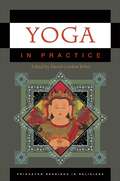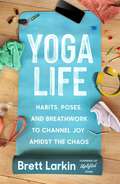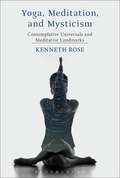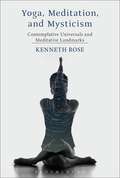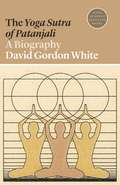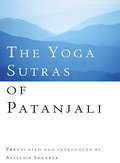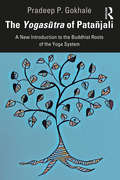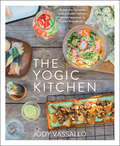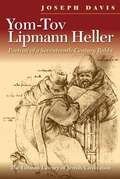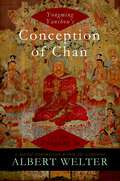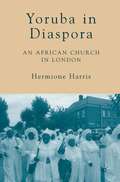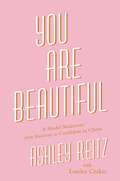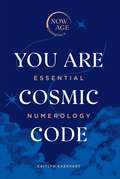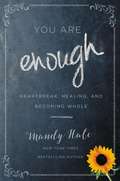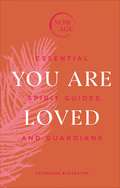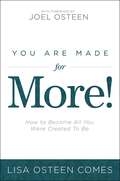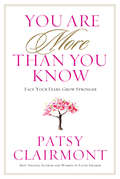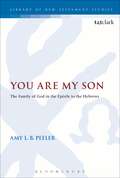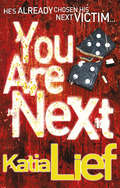- Table View
- List View
Yoga in Practice
by David Gordon WhiteYoga is a body of practice that spans two millennia and transcends the boundaries of any single religion, geographic region, or teaching lineage. In fact, over the centuries there have been many "yogas"--yogas of battlefield warriors, of itinerant minstrels and beggars, of religious reformers, and of course, the yogas of mind and body so popular today. Yoga in Practice is an anthology of primary texts drawn from the diverse yoga traditions of India, greater Asia, and the West. This one-of-a-kind sourcebook features elegant translations of Hindu, Buddhist, Jain, and even Islamic yogic writings, many of them being made available in English for the very first time. Collected here are ancient, colonial, and modern texts reflecting a broad range of genres, from an early medical treatise in Sanskrit to Upanishadic verses on sacred sounds; from a Tibetan catechetical dialogue to funerary and devotional songs still sung in India today; and from a 1930s instructional guide by the grandfather of contemporary yoga to the private papers of a pioneer of tantric yoga in America. Emphasizing the lived experiences to be found in the many worlds of yoga, Yoga in Practice includes David Gordon White's informative general introduction as well as concise introductions to each reading by the book's contributors.
Yoga in Practice
by David Gordon WhiteYoga is a body of practice that spans two millennia and transcends the boundaries of any single religion, geographic region, or teaching lineage. In fact, over the centuries there have been many "yogas"--yogas of battlefield warriors, of itinerant minstrels and beggars, of religious reformers, and of course, the yogas of mind and body so popular today. Yoga in Practice is an anthology of primary texts drawn from the diverse yoga traditions of India, greater Asia, and the West. This one-of-a-kind sourcebook features elegant translations of Hindu, Buddhist, Jain, and even Islamic yogic writings, many of them being made available in English for the very first time. Collected here are ancient, colonial, and modern texts reflecting a broad range of genres, from an early medical treatise in Sanskrit to Upanishadic verses on sacred sounds; from a Tibetan catechetical dialogue to funerary and devotional songs still sung in India today; and from a 1930s instructional guide by the grandfather of contemporary yoga to the private papers of a pioneer of tantric yoga in America. Emphasizing the lived experiences to be found in the many worlds of yoga, Yoga in Practice includes David Gordon White's informative general introduction as well as concise introductions to each reading by the book's contributors.
Yoga Life: Habits, Poses, and Breathwork to Channel Joy Amidst the Chaos
by Brett Larkin&“Brett translates the magic of ancient yoga for those who need it most.&” —James Nestor, New York Times bestselling author of BreathOverwhelmed? Overscheduled? Want to access the benefits of yoga, but can&’t seem to make it to the mat? Beat stress with a yoga ritual that works for you in 20-minutes or less. Featuring adaptations for anxiety, weight loss, injury, and prenatal yoga, this "playful and real" (Elena Brower) guide is a must-read for beginners and seasoned yoga teachers alike. We all know that yoga can calm your mind and heal your body, but let&’s be real: It can be hard to cram one more thing into your messy, stressful, time-crunched life. Good news! If you're not making it to the mat, the problem isn&’t you—it&’s the yoga you&’re practicing. Award-winning instructor and Uplifted Yoga founder Brett Larkin is here to help you design an adaptable, personalized practice, and cut to the chase with quick yoga habits that soothe your soul. With the support of quizzes and thirty book-exclusive companion videos you&’ll learn: A five-step method to design a personal practice that works for your schedule. How to adapt your practice to meet your physical, mental, and emotional needs. More than a dozen yoga habits that will help you calm your mind and body, even if you never manage to make it to the mat. Grounded in the wisdom of yoga&’s original texts, Brett reminds us that yoga was always meant to fit easily into our everyday lives. Whether you&’re a beginner or a life-long practitioner, Yoga Life is your new go-to for a personal, transformative, joyful at-home practice to strengthen your mind, body, and spirit.
Yoga, Meditation, and Mysticism: Contemplative Universals and Meditative Landmarks
by Kenneth RoseContemplative experience is central to Hindu yoga traditions, Buddhist meditation practices, and Catholic mystical theology, and, despite doctrinal differences, it expresses itself in suggestively similar meditative landmarks in each of these three meditative systems. In Yoga, Meditation and Mysticism, Kenneth Rose shifts the dominant focus of contemporary religious studies away from tradition-specific studies of individual religious traditions, communities, and practices to examine the 'contemplative universals' that arise globally in meditative experience. Through a comparative exploration of the itineraries detailed in the contemplative manuals of Theravada Buddhism, Patañjalian Yoga, and Catholic mystical theology, Rose identifies in each tradition a moment of sharply focused awareness that marks the threshold between immersion in mundane consciousness and contemplative insight. As concentration deepens, the meditator steps through this threshold onto a globally shared contemplative itinerary, which leads through a series of virtually identical stages to mental stillness and insight. Rose argues that these contemplative universals, familiar to experienced contemplatives in multiple traditions, point to a common spiritual, mental, and biological heritage. Pioneering the exploration of contemplative practice and experience with a comparative perspective that ranges over multiple religious traditions, religious studies, philosophy, neuroscience, and the cognitive science of religion, this book is a landmark contribution to the fields of contemplative practice and religious studies.
Yoga, Meditation, and Mysticism: Contemplative Universals and Meditative Landmarks
by Kenneth RoseContemplative experience is central to Hindu yoga traditions, Buddhist meditation practices, and Catholic mystical theology, and, despite doctrinal differences, it expresses itself in suggestively similar meditative landmarks in each of these three meditative systems. In Yoga, Meditation and Mysticism, Kenneth Rose shifts the dominant focus of contemporary religious studies away from tradition-specific studies of individual religious traditions, communities, and practices to examine the 'contemplative universals' that arise globally in meditative experience. Through a comparative exploration of the itineraries detailed in the contemplative manuals of Theravada Buddhism, Patañjalian Yoga, and Catholic mystical theology, Rose identifies in each tradition a moment of sharply focused awareness that marks the threshold between immersion in mundane consciousness and contemplative insight. As concentration deepens, the meditator steps through this threshold onto a globally shared contemplative itinerary, which leads through a series of virtually identical stages to mental stillness and insight. Rose argues that these contemplative universals, familiar to experienced contemplatives in multiple traditions, point to a common spiritual, mental, and biological heritage. Pioneering the exploration of contemplative practice and experience with a comparative perspective that ranges over multiple religious traditions, religious studies, philosophy, neuroscience, and the cognitive science of religion, this book is a landmark contribution to the fields of contemplative practice and religious studies.
The "Yoga Sutra of Patanjali": A Biography
by David Gordon WhiteConsisting of fewer than two hundred verses written in an obscure if not impenetrable language and style, Patanjali's Yoga Sutra is today extolled by the yoga establishment as a perennial classic and guide to yoga practice. As David Gordon White demonstrates in this groundbreaking study, both of these assumptions are incorrect. Virtually forgotten in India for hundreds of years and maligned when it was first discovered in the West, the Yoga Sutra has been elevated to its present iconic status—and translated into more than forty languages—only in the course of the past forty years.White retraces the strange and circuitous journey of this confounding work from its ancient origins down through its heyday in the seventh through eleventh centuries, its gradual fall into obscurity, and its modern resurgence since the nineteenth century. First introduced to the West by the British Orientalist Henry Thomas Colebrooke, the Yoga Sutra was revived largely in Europe and America, and predominantly in English. White brings to life the improbable cast of characters whose interpretations—and misappropriations—of the Yoga Sutra led to its revered place in popular culture today. Tracing the remarkable trajectory of this enigmatic work, White’s exhaustively researched book also demonstrates why the yoga of India’s past bears little resemblance to the yoga practiced today.
The "Yoga Sutra of Patanjali": A Biography
by David Gordon WhiteConsisting of fewer than two hundred verses written in an obscure if not impenetrable language and style, Patanjali's Yoga Sutra is today extolled by the yoga establishment as a perennial classic and guide to yoga practice. As David Gordon White demonstrates in this groundbreaking study, both of these assumptions are incorrect. Virtually forgotten in India for hundreds of years and maligned when it was first discovered in the West, the Yoga Sutra has been elevated to its present iconic status—and translated into more than forty languages—only in the course of the past forty years.White retraces the strange and circuitous journey of this confounding work from its ancient origins down through its heyday in the seventh through eleventh centuries, its gradual fall into obscurity, and its modern resurgence since the nineteenth century. First introduced to the West by the British Orientalist Henry Thomas Colebrooke, the Yoga Sutra was revived largely in Europe and America, and predominantly in English. White brings to life the improbable cast of characters whose interpretations—and misappropriations—of the Yoga Sutra led to its revered place in popular culture today. Tracing the remarkable trajectory of this enigmatic work, White’s exhaustively researched book also demonstrates why the yoga of India’s past bears little resemblance to the yoga practiced today.
The Yoga Sutra of Patanjali: A Biography (Lives of Great Religious Books #19)
by David Gordon WhiteConsisting of fewer than two hundred verses written in an obscure if not impenetrable language and style, Patanjali's Yoga Sutra is today extolled by the yoga establishment as a perennial classic and guide to yoga practice. As David Gordon White demonstrates in this groundbreaking study, both of these assumptions are incorrect. Virtually forgotten in India for hundreds of years and maligned when it was first discovered in the West, the Yoga Sutra has been elevated to its present iconic status—and translated into more than forty languages—only in the course of the past forty years.White retraces the strange and circuitous journey of this confounding work from its ancient origins down through its heyday in the seventh through eleventh centuries, its gradual fall into obscurity, and its modern resurgence since the nineteenth century. First introduced to the West by the British Orientalist Henry Thomas Colebrooke, the Yoga Sutra was revived largely in Europe and America, and predominantly in English. White brings to life the improbable cast of characters whose interpretations—and misappropriations—of the Yoga Sutra led to its revered place in popular culture today. Tracing the remarkable trajectory of this enigmatic work, White’s exhaustively researched book also demonstrates why the yoga of India’s past bears little resemblance to the yoga practiced today.
The Yoga Sutra of Patanjali: A Biography (Lives of Great Religious Books #19)
by David Gordon WhiteConsisting of fewer than two hundred verses written in an obscure if not impenetrable language and style, Patanjali's Yoga Sutra is today extolled by the yoga establishment as a perennial classic and guide to yoga practice. As David Gordon White demonstrates in this groundbreaking study, both of these assumptions are incorrect. Virtually forgotten in India for hundreds of years and maligned when it was first discovered in the West, the Yoga Sutra has been elevated to its present iconic status—and translated into more than forty languages—only in the course of the past forty years.White retraces the strange and circuitous journey of this confounding work from its ancient origins down through its heyday in the seventh through eleventh centuries, its gradual fall into obscurity, and its modern resurgence since the nineteenth century. First introduced to the West by the British Orientalist Henry Thomas Colebrooke, the Yoga Sutra was revived largely in Europe and America, and predominantly in English. White brings to life the improbable cast of characters whose interpretations—and misappropriations—of the Yoga Sutra led to its revered place in popular culture today. Tracing the remarkable trajectory of this enigmatic work, White’s exhaustively researched book also demonstrates why the yoga of India’s past bears little resemblance to the yoga practiced today.
The Yoga Sutras Of Patanjali (Sacred Teachings Ser.)
by Alistair ShearerThe basic questions of Who Am I? Where Am I Going? What Is the Purpose of Life? are asked by every generation, and Patanjali's answers (given in the third century BC) form one of the oldest spiritual texts in the world. 'That which unites' is called 'Yoga' - and is thus much broader than the form of exercise so popular today. It is a way to restore our lost wholeness, our integrity as complete human beings, by unifying the personality around a centre that is silent and unbounded. Alistair Shearer's superb introduction and translation bring these ancient, vital teachings to life in the modern world and are for all those who seek the benefits of self-knowledge.
The Yogasūtra of Patañjali: A New Introduction to the Buddhist Roots of the Yoga System
by Pradeep P. GokhaleThis book offers a systematic and radical introduction to the Buddhist roots of Pātañjala-yoga, or the Yoga system of Patañjali. By examining each of 195 aphorisms (sūtras) of the Yogasūtra and discussing the Yogabhāṣya, it shows that traditional and popular views on Pātañjala-yoga obscure its true nature. The book argues that Patañjali’s Yoga contains elements rooted in both orthodox and heterodox philosophical traditions, including Sāṅkhya, Jaina and Buddhist thought. With a fresh translation and a detailed commentary on the Yogasūtra, the author unearths how several of the terms, concepts and doctrines in Patañjali’s Yoga can be traced to Buddhism, particularly the Abhidharma Buddhism of Vasubandhu and the early Yogācāra of Asaṅga. The work presents the Yogasūtra of Patañjali as a synthesis of two perspectives: the metaphysical perspective of Sāṅkhya and the empirical–psychological perspective of Buddhism. Based on a holistic understanding of Yoga, the study explores key themes of the text, such as meditative absorption, means, supernormal powers, isolation, Buddhist conceptions of meditation and the interplay between Sāṅkhya and Buddhist approaches to suffering and emancipation. It further highlights several new findings and clarifications on textual interpretation and discrepancies. An important intervention in Indian and Buddhist philosophy, this book opens up a new way of looking at the Yoga of Patañjali in the light of Buddhism beyond standard approaches and will greatly interest scholars and researchers of Buddhist studies, Yoga studies, Indian philosophy, philosophy in general, literature, religion and comparative studies, Indian and South Asian Studies and the history of ideas.
The Yogasūtra of Patañjali: A New Introduction to the Buddhist Roots of the Yoga System
by Pradeep P. GokhaleThis book offers a systematic and radical introduction to the Buddhist roots of Pātañjala-yoga, or the Yoga system of Patañjali. By examining each of 195 aphorisms (sūtras) of the Yogasūtra and discussing the Yogabhāṣya, it shows that traditional and popular views on Pātañjala-yoga obscure its true nature. The book argues that Patañjali’s Yoga contains elements rooted in both orthodox and heterodox philosophical traditions, including Sāṅkhya, Jaina and Buddhist thought. With a fresh translation and a detailed commentary on the Yogasūtra, the author unearths how several of the terms, concepts and doctrines in Patañjali’s Yoga can be traced to Buddhism, particularly the Abhidharma Buddhism of Vasubandhu and the early Yogācāra of Asaṅga. The work presents the Yogasūtra of Patañjali as a synthesis of two perspectives: the metaphysical perspective of Sāṅkhya and the empirical–psychological perspective of Buddhism. Based on a holistic understanding of Yoga, the study explores key themes of the text, such as meditative absorption, means, supernormal powers, isolation, Buddhist conceptions of meditation and the interplay between Sāṅkhya and Buddhist approaches to suffering and emancipation. It further highlights several new findings and clarifications on textual interpretation and discrepancies. An important intervention in Indian and Buddhist philosophy, this book opens up a new way of looking at the Yoga of Patañjali in the light of Buddhism beyond standard approaches and will greatly interest scholars and researchers of Buddhist studies, Yoga studies, Indian philosophy, philosophy in general, literature, religion and comparative studies, Indian and South Asian Studies and the history of ideas.
The Yogic Kitchen
by Jody VassalloFollow the Ayurvedic path to health with this ancient approach to food as medicine
Yom-Tov Lipmann Heller: Portrait of a Seventeenth-Century Rabbi (The Littman Library of Jewish Civilization)
by Joseph DavisThis study portrays a man and an age. Yom-Tov Lipmann Heller (1578-1654), author of the famous Mishnah commentary Tosafot yom tov, was a major talmudist, a disciple of the legendary Rabbi Judah Loew of Prague, and himself the distinguished chief rabbi of Prague and Cracow. The time in which he lived began as a ‘golden age’ for the Jews of Prague and the Jews of Poland, an age of prosperity and the rise of Jewish mysticism. During Heller’s lifetime, however, the golden age changed to darkness, and prosperity gave way to war, persecution, plague, and massacres. It was the end of the Middle Ages, the last generation before Spinoza and Shabbetai Zevi. Scholar, preacher, religious and communal leader, Heller embodied a religious and cultural ideal; he was the very model of a seventeenth-century rabbi. Born in Germany, he moved from one end of the world of Ashkenazi Jewry to the other, first to Prague, and then to Poland and the Ukraine. His life was enmeshed in a web of family ties, and bounded by complex rules of class and religion. His writing reflects not only the full heritage of medieval Jewish thought and its crystallization in the seventeenth century, but also the time and place in which he lived. In many ways, he exemplified his age, its achievements, and its limitations. Carefully researched and well written, Joseph Davis’s work is the definitive biography of Heller. He presents a richly detailed study of Heller’s worldview, his conception of Judaism, of the world around him, and of himself within it: the seventeenth century seen through seventeenth-century eyes. Heller was eyewitness to momentous, epoch-making events: the beginning of the Thirty Years’ War and the massacres of 1648. He lived through a time of tumultuous change. Texts such as the sermon in which Heller responded to the new astronomy of Brahe and Kepler, or a poem on the massacres of 1648 in which he enlarged the capacity of Hebrew poetry to express horror are significant in the larger context of Jewish and European history. Heller’s world-view was not static or motionless. His world changed greatly during his lifetime, and his views of it likewise changed greatly over the fifty years from his first writings to his last, from youth to middle age to old age. His personal circumstances also contributed to this: the experience of betrayal, arrest, imprisonment, the death of his children, and other misfortunes led him to wrestle with such questions as the differences between Jews and non-Jews and the meaning of suffering. Davis weaves these developments succinctly into a fascinating narrative that does full justice both to Heller and the momentous events he experienced.
Yongming Yanshou's Conception of Chan in the Zongjing lu: A Special Transmission Within the Scriptures
by Albert WelterYongming Yanshou ranks among the great thinkers of the Chinese and East Asian Buddhist traditions, one whose legacy has endured for more than a thousand years. Albert Welter offers new insight into the significance of Yanshou and his major work, the Zongjing lu, by showing their critical role in the contested Buddhist and intellectual territories of the Five Dynasties and early Song dynasty China. Welter gives a comprehensive study of Yanshou's life, showing how Yanshou's Buddhist identity has been and continues to be disputed. He also provides an in-depth examination of the Zongjing lu, connecting it to Chan debates ongoing at the time of its writing. This analysis includes a discussion of the seminal meaning of the term zong as the implicit truth of Chan and Buddhist teaching, and a defining notion of Chan identity. Particularly significant is an analysis of the long underappreciated significance of the Chan fragments in the Zongjing lu, which constitute some of the earliest information about the teachings of Chan's early masters. In light of Yanshou's advocacy of a morally based Chan Buddhist practice, Welter also challenges the way Buddhism, particularly Chan, has frequently been criticized in Neo-Confucianism as amoral and unprincipled. Yongming Yanshou's Conception of Chan in the Zongjing lu concludes with an annotated translation of fascicle one of the Zongjing lu, the first translation of the work into a Western language.
Yoruba in Diaspora: An African Church in London (Contemporary Anthropology of Religion)
by H. HarrisThe Nigerian diaspora is now world-wide, and when Yoruba travel, they take with them their religious organizations. As a member of the Cherubim and Seraphim church in London for over thirty years, anthropologist Hermione Harris explores a world of prayer, spirit possession, and divination through dreams and visions.
You Are Beautiful: A Model Makeover from Insecure to Confident in Christ
by Ashley ReitzYOU ARE BEAUTIFUL shows young women who feel like they are not thin/pretty/good enough how to find true confidence as they discover their identity in Christ.Have you ever felt like you were not enough-not pretty enough, thin enough, or enough enough?You will never be all that the world demands you to be-it's impossible. Just ask curve model Ashley Reitz, who struggled for years with feeling overlooked, frizzy-haired, round-faced, and chubby. Her insecurity, disordered eating, and weight issues derailed her happiness and set her on a treadmill of constantly trying to be enough and never succeeding.Even after Ashley grew up, graduated from beauty school, and launched a successful international modeling career, it took overcoming some painfully dark circumstances to provide her with the needed clarity and strength to confront her deeply rooted insecurities. She realized she had to surrender daily, actively seeking her acceptance and finding her worth in Jesus alone. Finally, she realized the truth: She was already beautiful.And so are you! Join Ashley as she explores topics of confidence, beauty, positive body image, and the maddening-and futile-pursuit of perfection. Like an encouraging friend and sister, Ashley speaks truth and healing into your life as you:Rethink your true source of identity and confidence.Choose physical and spiritual wellness over our culture's unnatural fixation with being "skinny."Take back the power you and millions of others have unwittingly handed over to the media.Learn to believe God's words of love and value about you, every day.Are inspired by a formerly insecure "hot mess" who has been transformed through seeking her confidence in Christ alone.Believe that you are enough, because Jesus said so. p.p1 {margin: 0.0px 0.0px 0.0px 48.0px; text-indent: -48.0px; font: 8.0px 'Times New Roman'} p.p2 {margin: 0.0px 0.0px 0.0px 0.0px; font: 8.0px 'Times New Roman'} span.s1 {font-kerning: none}
You Are Cosmic Code: Essential Numerology (Now Age series) (Now Age Series)
by Kaitlyn KaerhartYour fate isn't written in the stars, it's in your cosmic code...You know your astrological sign but do you know your numbers? Get to know the ancient art of numerology and the numbers that rule your life.Numerologist Kaitlyn Kaerhart introduces the most important numbers for you and the simple method to discover them. Understand your life path number, personal year cycles, life expression numbers, Karmic lessons and balance numbers. They all have important roles, will help you understand who you are and how to live to your full potential.Find out how numerology works to find clarity and purpose every day.
You Are Loved: Essential Spirit Guides and Guardians (Now Age Ser.)
by Catherine BjörkstenWe all have spirit guides. Get to know yours.Guardians and angels, goddesses, animals and totems and elemental spirits - discover who your guides are and how they can power you through every day life. Spot the signs to look for to know they are present and find out how to call on them. Tune in to their wisdom and understand who you are so you can fulfil your goals - and true potential.
You Are Made for More!: How to Become All You Were Created to Be (Playaway Adult Nonfiction Ser.)
by Lisa Osteen Comes"Whatever difficulties you face," Lisa Osteen Comes encourages readers, "I believe you are made for more."Lisa shares from her own life stories of facing birth defects, limiting labels as a young woman, an unwanted divorce, criminal attack, infertility, and broken dreams. With every story, in every chapter, she delivers biblical truths and practical help for overcoming hardship and loss.Her down-to-earth style, humor, spiritual wisdom, and optimism engage readers, who will remember and repeat Lisa's memorable principles for daily living:· You can't grasp the future, if you're hanging onto the past.· You weren't made for the pit, but for the palace.· It's not over till God says it's over.· God's at work in you, making a masterpiece.· Let your scars become stars.In a time when more readers face financial peril, uncertain work lives, and feelings of fragility in a fast-paced and overwhelming world, Lisa's message shows how to not only get through the day but, how to catch new vision for a bold and bright life.
You Are More Than You Know: Face Your Fears, Grow Stronger
by Patsy ClairmontThrough humorous and poignant stories, Patsy reveals how she went from a house-bound agoraphobic to a world-traveling public speaker and entertainer.
You Are My Son: The Family of God in the Epistle to the Hebrews (The Library of New Testament Studies #486)
by Amy L. PeelerThe author of Hebrews calls God 'Father' only twice in his sermon. This fact could account for scholarship's lack of attention to the familial dynamics that run throughout the letter. Peeler argues, however, that by having God articulate his identity as Father through speaking Israel's Scriptures at the very beginning and near the end of his sermon, the author sets a familial framework around his entire exhortation. The author enriches the picture of God's family by continually portraying Jesus as God's Son, the audience as God's many sons, the blessings God bestows as inheritance, and the trials God allows as pedagogy. The recurrence of the theme coalesces into a powerful ontological reality for the audience: because God is the Father of Jesus Christ, they too are the sons of God. But even more than the model of sonship, Jesus' relationship with his Father ensures that the children of God will endure the race of faith to a successful finish because they are an integral part of comprehensive inheritance promised by his Father and secured by his obedience. Because of the familial relationship between God and Jesus, the audience of Hebrews - God's children - can remain in the house of God forever.
You Are Next: (Karin Schaeffer 1) (Karin Schaeffer #1)
by Katia LiefAn ex-cop with a death wish. A serial killer with a gruesome agenda...Detective Karin Schaeffer was a happily married mother until she got too close to catching a serial killer.The press nickname him The Domino Killer because he systematically murders whole families, leaving a trail of bloody dominoes as the only clues to his next victim. Having brutally slain Karin's husband and child, he left her a chilling message scrawled in her daughter's blood: YOU ARE NEXT.But now the Domino Killer has escaped prison and the police believe he's on his way to find her. And Karin is waiting...
